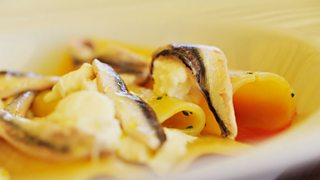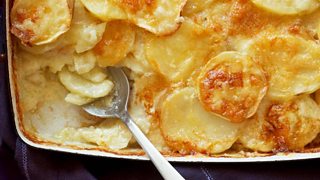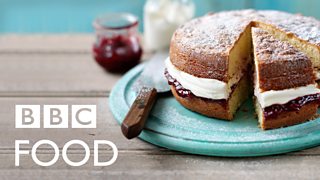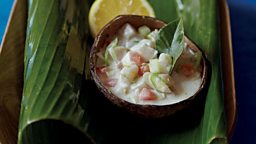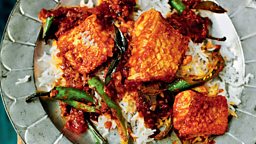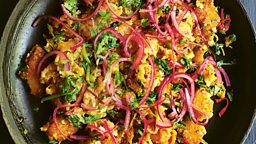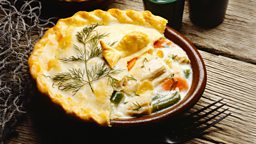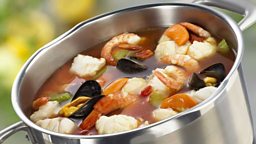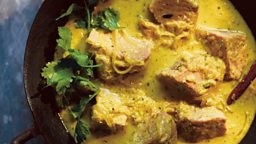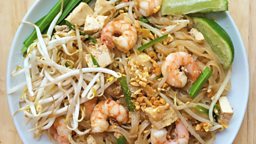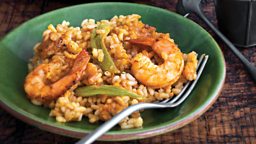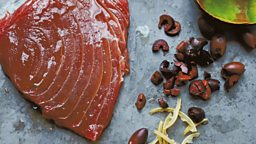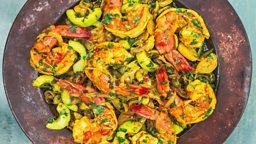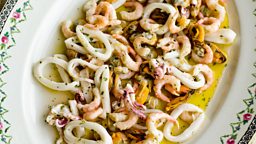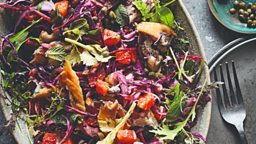Hot Oak-Smoked Salmon
Award-winning food writer Diana Henry demonstrates how to smoke your own salmon at home
Hot oak-smoked salmon
You can cold-smoke or hot-smoke food. Hot-smoking is the easiest for the home-smoker to start with, and produces food that is fully cooked.
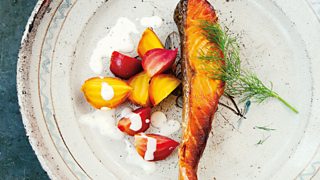
, or , to be kept up to date with all cookery items.
Ingredients
Serves 4
About 50g (1 戮 oz) fine sea salt
2 tbsp soft light brown sugar
4 salmon fillets of an even medium thickness (about 150g/5 陆 oz each)
1 tbsp oak sawdust or shavings
Preparation method
Mix the salt with the sugar and sprinkle it evenly on the fish fillets. Refrigerate for 10 minutes (thick steaks can take up to 30 minutes). Rinse the fish under running water, then pat dry and return to the refrigerator for three hours so the salt can permeate better.
Put the sawdust or shavings in the base of a stove-top smoker and insert the drip tray (the little tray underneath the rack that comes with the smoker). Line the drip dray with foil (it makes for easier cleaning, you can just throw the foil away). Put the wire rack on top, arrange the fish on the rack (leaving room around each fillet), then slide the lid on. (You can use a wok if you don鈥檛 have a stove-top smoker).
Set the smoker over a medium heat. As soon as wisps of smoke start to appear, or you can smell the smoke, reduce the heat to low and smoke the fillets for about 20 minutes.
Turn the heat off, and wait until you can鈥檛 see any more smoky wisps, then open the smoker and check that the fish is cooked through. It should be opaque and not at all glassy looking. If it isn鈥檛 quite cooked through, you can put the heat on again or you can finish the fish off by steaming. You can eat this straight away or wrap it in cling film and, once cool, refrigerate for up to 2 days. If you want to serve it later and have it hot you can reheat it, wrapped in foil, in a medium oven.
How to use
This can be served with roast beetroot, as they do in Scandinavia, drizzled with buttermilk and served with warm potatoes tossed with dill. It can also be cooked in a gratin with cream and spinach.
More about smoking food
You can cold-smoke or hot-smoke food. Cold-smoking produces food that can be eaten raw (such as smoked salmon), or needs to be cooked further (such as smoked haddock). It takes attention and experience to do it well, and more specialist equipment. The food is smoked for a longer period at a temperature no highter than 29 degrees Centigrade (85F).
Hot-smoking - much more popular in Scandinavia than here - is an easier place for the home-smoker to start, and produces food that is fully cooked. The food is smoked between 82 and 93 degrees Centigrade (180 - 200F) for fish, and up to 115 degrees Centigrade (240F) for poultry and meat.
Serious smokers often cold-smoke meat and fish for a while before hot-smoking it, to impart a stronger smoky flavour. But it isn't essential. If you are hot-smoking, you can smoke the food for flavour, then finish it off in the oven or under a grill. That way you get both the taste of smoke and the pleasure of a golden, crispy skin.
If you are smoking in a wok, simply put 1tbsp of wood sawdust in the boottom. Line the wok with foil and put a metal rack inside. Put the food to be smoked on to the rack, leaving space in between if you are cooking several pieces so that the smoke can circulate. Cover tightly with a lid (if it doesn't sit tightly you may have to put a band of scrunched-up foil where the wok and lid meet), and put on your extractor fan. Set the wok over a medium heat. Within a couple of minutes you will smell the smoke and see the first wisps. When this happens, reduce the heat to low and leave the food to hot-smoke. Check after the allotted time and continue to smoke if the food isn't cooked through, or you can finish the cooking by roasting or frying.
Food is always smoked over a hardwood, the most commom examples being oak, hickory and maple. The wood shouldn't have been treated with chemicals, or in any other way. You can use sawdust or shavings.
It's very hard to be completely specific about smoking times and even about flavour, so this recipe is simply a guide. You can alter the amount of salt used, the smoking time, the thickness of fish - and you can add flavours such dill, soy or fennel. Once you have the basics, you can go on your own adventures.
Browse previous recipes
Seeking to create perfect pumpkin soup, cracking curry or unbeatable bread and butter pudding?
More Food on the 主播大秀
-
![]()
Browse our selection of recipes from top chefs, cooks and food writers who have joined us on Woman's Hour...
-
![]()
Download this interview, or subscribe to the Cook the Perfect...downloads
-
![]()
Browse over 13,000 recipes on the 主播大秀 Food website
